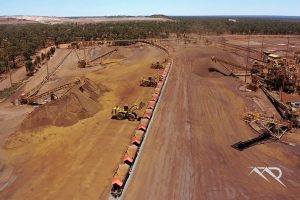St George Mining (ASX: SGQ) has discovered a significant clay-hosted rare earth elements (REE) system at its wholly owned Destiny project, in the Eastern Goldfields region of Western Australia.
St George acquired the Destiny project, originally called Woolgangie, earlier this year and in September began on-the-ground exploration activities. The Destiny project comprises a dominant landholding of 3,350 sq km in an underexplored region of the Coolgardie Mineral Field and takes in about 90km of the Ida Fault zone.
Drilling intersected thick zones of high-grade Total Rare Earth Oxide (TREO) – up to 42m thick. The REE mineralisation is hosted in a thick, near-surface clay zone confirmed by drilling over a 7km-long strike with mineralisation open in all directions and less than 10% of the target area tested.
Significant assay results include:
- WGAC0001: 8m @ 1,673ppm TREO, 342ppm MREO from 24m
- WGAC0026: 30m @ 1,885ppm TREO, 399ppm MREO from 20m, including
- 6m @ 3,578ppm TREO, 755ppm MREO from 32m, and including
- 2m @ 5,125ppm TREO, 1,199ppm MREO from 32m
- WGAC0030: 42m @ 1,832ppm TREO, 351ppm MREO from 12m, including
- 14m @ 2,622ppm TREO, 515ppm MREO from 38m
- WGAC0100: 29m @ 1,042ppm TREO, 200ppm MREO from 14m
High-value Magnetic Rare Earth Oxides (MREO) – such as neodymium and praseodymium needed for magnets used in electric vehicle motors – comprise a high percentage of TREO; 19% on average across all drill holes. Heavy Rare Earth Oxides (HREO) comprise 17% of TREO based on the average across all drill holes.
The numerous thick, high-grade REE intercepts in the widely spaced maiden 61 air-core drill program confirm the prospectivity for mineralisation of significant scale.
Commenting on the rare earths discovery at Destiny, St George executive chairman John Prineas said:
“These are ground-breaking results for the company in our first-ever drill program at Destiny, with high-grade rare earths confirmed along a 7km-long strike of the Ida Fault.
“The high grades returned in the assays are very exciting. Together with the scale of the prospective geology – which may extend for more than 70km – the potential of the project is impressive.
“Importantly, the assays show a high proportion of sought-after magnetic rare earths – a feature that could be a huge value driver for Destiny.
“The flat-lying nature of the REE mineralisation and the host clay zone allow for a fairly simple follow-up exploration program of drilling along strike as well as infill drilling. We want to be back drilling at Destiny early in 2024 to unlock the full potential of this exciting REE discovery.
“The REE project is complementary to our lithium and nickel assets, enhancing St George’s position as a high-impact explorer of multiple battery metals in the Tier 1 jurisdiction of Western Australia.
“The Destiny project covers 3,350 sq km and takes in more than 90km of the Ida fault – a regional scale crustal shear zone that is gaining increased interest as a control on major mineral deposits in Western Australia. The Kathleen Valley lithium deposit (156Mt @ 1.4% Li2O)2 of Liontown (ASX: LTR) and the Mt Ida lithium deposit (14.6Mt @ 1.2% Li2O)3 of Delta Lithium (ASX: DLI) are two major lithium deposits associated with the Ida Fault.
“We are excited to control more than 90km of the Ida Fault at Destiny – and another 30km strike at our Mt Alexander Project – with advanced targets for lithium, rare earths, nickel and copper.”



